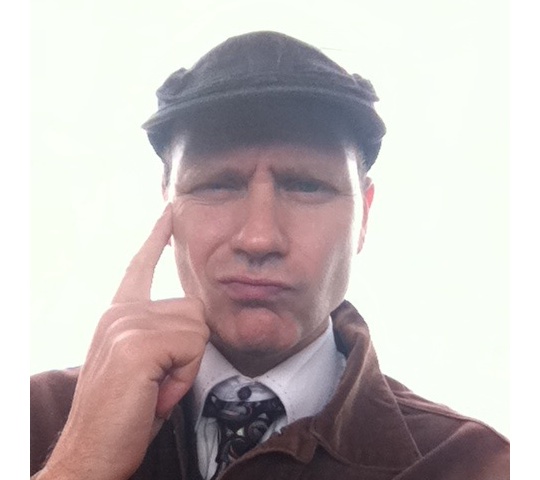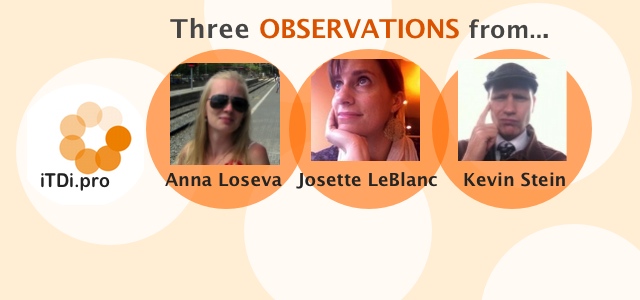Watch Me, Watch me – Kevin Stein

I’m not sure how most people feel about observation. But I’m curious to find out, so if you have a minute, please take this short survey on how you would rank “lesson observations” in relation to things like “sleeping in on Sunday morning” and “going to the dentist.”
https://www.surveymonkey.com/s/HHFYBYS
Even before the survey results come in, I’m guessing that lesson observations, even peer lesson observations, are not going to be super popular. Which, when I think about my daughter, seems pretty odd.
You see, my daughter is 6 years old. Her three favourite things in the world are running as fast as she can, practicing gymnastics, and playing piano. If I or my wife are around, my daughter invariably calls out, “Watch this,” before she cartwheels across the living room, taps out a song on the piano, or sprints up the street. When I compare my daughter’s boundless desire to be observed with my own feelings about classroom observation, I can’t help but feel that, as a teacher, I have misplaced something important, something joyful.
What is it about the way I watch my daughter as compared to how classroom observations are conducted, which has created this psychic gap?
When my daughter is running up and down the street, she will often ask me to use a stopwatch to time her. I use the lap function to keep track of how long it takes her to run the first third, the middle third, and the last third of the distance. Sometimes I ask her “when were you running fastest, at the beginning, the middle or the end?” Sometimes she asks me. But I rarely, if ever say things like, “That was a very interesting sprint,” or “I don’t think the pacing of your run was very even.”
In “Beyond Rashomon,” John Fanselow (1977, p.27-28) points out that the words teachers use when observing and commenting on each others lessons—words like ‘meaningful’ and ‘interesting’—often “have good and bad connotations…are in themselves judgmental as well as descriptive. Judgment means someone’s ego is involved, and this can interfere with perception.” Like keeping track of a runners time, collecting hard data during an observation and sharing that data during post-observation follow up can help keep the focus away from the kind of purely personal evaluations which so often land on our ears with the slap of disapproval. In some of my favourite observations, my fellow teachers have: used a stop-watch to keep track of how long each activity lasted; categorised the types of teacher talk I used; counted the number of words each student said during a class; and even made a map of where I was standing in the room during each activity and what materials I used at each location. In each an every case, I was given another piece of data to more fully see what was happening in my class without the sense that I was being inherently judged.
After my daughter’s piano lessons, the teacher will usually tell us one aspect of her playing that she would like us to focus on during the week. Sometimes it is paying more attention to rhythm. Sometimes is varying the intensity and duration of the notes played. We all know just what and why we are going to pay attention to during piano practice over the course of the week. In a similar vein, Jack Richards (1995) suggests that during peer observations, the observee give the observer a task which entails focusing on a particular aspect of the lesson and only collecting relevant data. Tasks can include measuring time on task, notating types of student responses to questions, or identifying classroom management techniques used during a lesson.
In any classroom, so much is going on at any one time that, if we try to observe the class as a whole, there’s a very good chance we won’t notice very much of anything. In addition, at least for me, knowing the focus of the observation ahead of time means I can let go of one specific worry while I teach, allowing me a little bit more psychological breathing room so that I can attend to things I might normally miss as I teach.
I don’t want to sound like I’m bragging, but my daughter can stand on her hands, fall into a back bend, and then scramble around the room like a crab. Still, until last week, she couldn’t do a somersault. Every time she tried, she would land with a thud on her back. I took a few videos just before she started to tumble over. It turned out that the moment before she fell forward, she kicked off and that extra burst of momentum propelled her over just fast enough that she had no time to curl her back. Hence the thud. After watching the video and talking with me about the other things she could already do, she bent down, slowly walked herself into a ball, curled herself over and rolled across the carpet.
Peter Maingay (1988, p. 119-129) says, “Much of what a teacher does in a language-teaching classroom is ritual behaviour rather than principled behaviour. The most important role of an observer in most, if not all, observations is that of making teachers think about what they do: of drawing their attentions to the principles behind the rituals, of leading them away from ritual behaviour towards principled behaviour.” So observation is not just about presenting data, it’s about creating a space where a teacher can revisit what they already know about teaching and compare that knowledge with what is happening in the classroom.
A few weeks ago, after observing my lesson one of my co-workers pointed out that a vast majority of the language students were using in class was memorised content from a worksheet. That gave me a chance to think about the role of creative language in my classroom and the types of speaking activities I was using. I realised that how I was teaching was disconnected from some of my deeply held beliefs about how languages are actually learned. And in that moment, I could see the right way to naturally lean forward and tumble back into the kind of teaching I wanted to be doing.
John Fanselow (1988, p. 115) suggests that perhaps the goal of observation is not to, “help or evaluate,” but instead to provide teachers with a chance for self-exploration. Which seems perfectly right to me. I found out early on in this dad-thing, that when my daughter said, “Watch me,” it was sometimes (but not always) a request to help her find a way to figure things out for herself. She was almost never happy to be told exactly what to do. In the same way, I have rarely finished a post-observation feedback session where I was given an armful of prescriptive suggestions and felt like I was walking away with anything other than a whole lot of unnecessary baggage.
So whether it be peer or supervisory, I think keeping in mind some of the things that make a six year old happy when they are being watched, could go a long way to decreasing the anxiety and defusing the defensiveness that often colours our ideas of observation.
- First and foremost, an observers job is to watch, not to judge.
- Observer and observee need to talk things over and decide what to focus on during an observation before the observation takes place.
- Observers should not limit themselves to a taking a few notes as they are observing. They should collect as much data as possible, which is probably always a bit more than they have already managed to catch.
- Observers need to provide real chances for a teacher to see how what they are doing in class, what they believe they are doing, and what they believe they should be doing might be different.
- There should be enough room and time for the teacher to sort through the post-observation feedback and figure out for themselves what they are going to do next.
If observations, both peer and supervisory, followed these guidelines, I wonder if it would change how teachers feel about being observed in general. In spite of the negative experiences we have all probably had with observations, there is still something inherently positive about being watched. There is a kind of joy in knowing that what we do is important, that it’s worth observing. But to create a community in which all teachers can continue to grow and flourish, we need to find the right light with which to observe, the kind of light in which teachers can truly shine. Because in all of us, there’s still a child, waiting to cry out with a special kind of delight, “Watch me! Watch me!”
References:
Fanselow, J. F. (1977). Beyond Rashomon: conceptualizing and describing the teaching act. TESOL Quarterly 11(1), 17-39.
Fanselow, J. F. (1988). “Let’s See”: Contrasting Conversations About Teaching. TESOL Quarterly, 22(1), 113-130.
Maingay, P. (1988). Observation for training, development or assessment. In Explorations in teacher training: problems and issues, ed. by T. Duff, London: Longman Group UK LTD.
Richards, J. C. (1995). Towards reflective teaching. ENGLISH TEACHERS JOURNAL-ISRAEL-, 59-63.
Connect with Kevin and other iTDi Associates, Mentors, and Faculty by joining iTDi Community. Sign Up For A Free iTDi Account to create your profile and get immediate access to our social forums and trial lessons from our English For Teachers and Teacher Development courses.







 I’m sitting by the Chao Phraya river outside a house in the Bangplad area of Bangkok, Thailand where I’ve rented a room for a month. Behind me is Soi 70-2, a local neighborhood built on canals and swampland. Getting to this house, or anywhere else in the Soi, means walking along very narrow concrete paths lined closely on both sides by mostly one-story houses. Everyone has their doors and windows open, and I can’t help looking inside. That’s because I’m an outsider here – one who knows nothing about Thai culture except what I’ve read in books — so looking is what I do to learn. I look, I interpret, I ask around, and I make mistakes.
I’m sitting by the Chao Phraya river outside a house in the Bangplad area of Bangkok, Thailand where I’ve rented a room for a month. Behind me is Soi 70-2, a local neighborhood built on canals and swampland. Getting to this house, or anywhere else in the Soi, means walking along very narrow concrete paths lined closely on both sides by mostly one-story houses. Everyone has their doors and windows open, and I can’t help looking inside. That’s because I’m an outsider here – one who knows nothing about Thai culture except what I’ve read in books — so looking is what I do to learn. I look, I interpret, I ask around, and I make mistakes.




 If I ask you, some of you descend from one, two, perhaps more cultures, or know someone who is bicultural, multicultural. Your class as a total can be a multicultural hub, buzzing with countries, languages and various traditions and customs. It could be monocultural as well, which is also fine.
If I ask you, some of you descend from one, two, perhaps more cultures, or know someone who is bicultural, multicultural. Your class as a total can be a multicultural hub, buzzing with countries, languages and various traditions and customs. It could be monocultural as well, which is also fine.



 It was exploratory; a foot in the water for me, to see what children’s understanding of the world around them was. I was a new member of staff in a new area with no real plan for how the project would work, but despite this my new Head Teacher took a risk and allowed Culture Chat to go ahead! When the project began, I was nervous. I worried about what people would think. I worried I’d be laughed at. Most of all, I worried people wouldn’t want to talk openly about perspectives of the world. The atmosphere in Britain over the last 12 months has become less welcoming to foreigners, peaking over summer when the government backed a scheme of ‘Go Home’ vans being driven across London. The media regularly sensationalise reporting, but particularly in crimes relating to any ethnic minorities, which is resulting in a lack of tolerance, a divide, misconceptions and misunderstandings to seep into the public consciousness.
It was exploratory; a foot in the water for me, to see what children’s understanding of the world around them was. I was a new member of staff in a new area with no real plan for how the project would work, but despite this my new Head Teacher took a risk and allowed Culture Chat to go ahead! When the project began, I was nervous. I worried about what people would think. I worried I’d be laughed at. Most of all, I worried people wouldn’t want to talk openly about perspectives of the world. The atmosphere in Britain over the last 12 months has become less welcoming to foreigners, peaking over summer when the government backed a scheme of ‘Go Home’ vans being driven across London. The media regularly sensationalise reporting, but particularly in crimes relating to any ethnic minorities, which is resulting in a lack of tolerance, a divide, misconceptions and misunderstandings to seep into the public consciousness. It is forty one years since John Lennon wrote the renowned song ‘Imagine’. In it, he refers to a world without war, where people are equal with no religion or countries and the world lives in peace. How much has changed since this song?
It is forty one years since John Lennon wrote the renowned song ‘Imagine’. In it, he refers to a world without war, where people are equal with no religion or countries and the world lives in peace. How much has changed since this song?